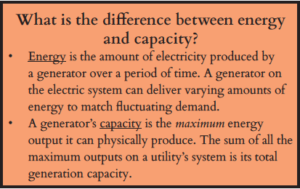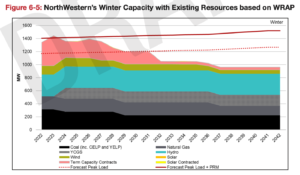By Ian Lund
Recently, the Montana Public Service Commission (PSC) opened an investigation on “resource adequacy.” Generally speaking, “resource adequacy” means a utility has enough available electricity resources to keep the lights on. In announcing its investigation, the PSC cast doubt on whether Montana’s utilities could keep the lights on. The PSC highlighted reports describing regional reliability risk and questioned whether NorthWestern Energy appropriately addresses that risk in its planning process. The investigation will feature a conference on December 8 and 9. It is possible that the PSC will use information presented at the conference to write new resource planning rules.
Utilities often weaponize the fear of being resource inadequate (sometimes referred to as a “capacity deficit”) to skirt utility commission oversight. They want decisions approved quickly: “Scrutinize our proposal for an expensive methane gas plant at your own peril,” a company may warn. “You wouldn’t want a blackout, would you?”
Resource adequacy is crucial for utilities planning out the next few decades of operation, but the full story is a lot more nuanced. In short, there are a multitude of creative ways that utilities can plan for resource adequacy that are good for customers and good for the planet. 
As explained in previous Down to Earth articles, the choice between blackouts or fossil fuel power plants is a false dichotomy. Not only are clean energy technologies more viable and less expensive than ever, there are numerous alternatives to building expensive new generation resources that utilities can use to provide reliable electric service for customers. The suite of solutions include virtual power plants consisting of distributed solar and battery systems networked together; energy efficiency investments; demand response technologies (smart thermostats, water heaters, and other appliances); and innovative and responsive rate designs. Combining low-cost renewable energy technology and fully utilizing demand-side solutions is the grid system of the future, a system in which many utilities are already heavily investing. This is the path toward cleaner energy and lower electricity bills for Montana ratepayers.
Montana utilities are also thinking about resource adequacy, but not in ways that are good for the climate or customers’ wallets. NorthWestern Energy’s long-term resource plan proposes building multiple methane gas plants in the coming years and continuing to rely on the Colstrip coal-fired power plant. Relying on these legacy fossil fuel resources is an imprudent path for Montana. Coal and gas are expensive options, and there are risks to relying on large centralized plants. Mechanical failures at plants have and will continue to result in the loss of hundreds of megawatts of power all at once, leading to the very situation reliability planning seeks to avoid.
Proponents of the antiquated energy system – including some Montana lawmakers – perpetuate a myth that the electricity grid cannot reliably operate on 100% carbon-free sources. However, numerous studies demonstrate that decarbonizing grids can be affordably done through geographically dispersed wind and solar projects paired with significant storage capacity. Both traditional pumped-hydro storage and new innovations such as Form Energy’s 100-hour iron-air batteries can charge using excess renewable energy when demand is low, and then provide multiple days of power when it’s needed most. Carbon-free resources such as these are only getting better and more affordable as the clean tech industry grows and federal and state governments demand decarbonization strategies.

When modeling NorthWestern Energy’s resources over time, the capacity values of Montana wind resources increases, decreasing the total need for new resources. This graph is from NorthWestern’s draft Integrated Resource Plan.
Almost all studies on decarbonizing the electric grid find that sharing energy is crucial to making a 100% clean grid affordable and reliable. Luckily for Montana, an interstate group of energy producers and utilities has already convened to work on this problem. The Western Resource Adequacy Program (WRAP) is an energy trading and sharing mechanism designed to help members maintain reliable service more affordably and efficiently. It will help its members coordinate with each other to share and exchange capacity resources. While WRAP does not obviate the need of the Montana PSC and utilities to assess resource adequacy, it is a critical tool in affordable decarbonization.
Montana regulators should be asking, how can regulation best protect customers from unnecessary and expensive investments in capacity resources such as new gas plants? Regulators should develop planning rules that ensure utilities rigorously assess the full range of cost-effective supply- and demand-side resources in their Integrated Resource Plans. Too often, utilities give expensive fossil fuels an edge in their analyses in order to justify new power plants. Instead, the PSC should demand utilities accurately and transparently identify and develop the least expensive resources. The obvious starting place is energy efficiency, which is achieved when changes anywhere in the system result in the use of less energy to provide equal or improved service.
Reducing and shifting peak energy demand also can significantly improve system reliability. Demand response, sometimes known as load management, is strategically applied energy conservation, and is used to lower energy peaks, reduce customer costs, and relieve stress on the grid. Often, demand response just shifts load temporarily when demand is unusually high. Utilities with robust demand-side management (DSM) programs can use demand response and energy efficiency programs to lower customer demand for energy, especially during peak hours when power costs are highest. Utilities are uniquely positioned to develop and achieve high participation in DSM programs. The PSC should promote integrated planning rules to ensure that utilities such as NorthWestern are pursuing and implementing DSM resources and that they are appropriately rewarded for such investments.
Finally, Montana regulators can encourage utilities to explore and adopt innovative rate designs that encourage customers to change their behavior to align with energy system constraints. This would help customers save money and result in a cleaner energy system. NorthWestern is one of the few utilities in the northwest without any innovative rate design to align customer demand with supply. The PSC should require utilities to study alternative rate designs as part of the resource planning process. At minimum, Montanans should pay escalating block rates, which means that energy used in excess of a certain threshold each month costs more than the standard rate, thus encouraging energy conservation. Historical data can help create a rate structure that considers peak loads and incentivizes energy conservation during critical times. NorthWestern Energy’s deployment of advanced meters gives it ample data to immediately begin designing a pilot time-of-use rate structure.
Other utilities are already planning for clean resource adequacy. It’s time that Montana’s utilities drop the tired narrative that fossil fuel plants are the only way to ensure the lights stay on. In fact, they should be at the bottom of the list when considering customers’ bills and the climate.
This article was published in the Dec. 2022 issue of Down To Earth.

